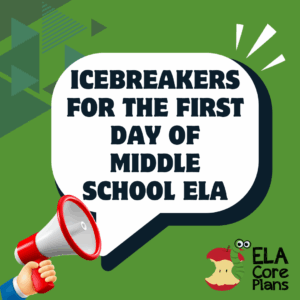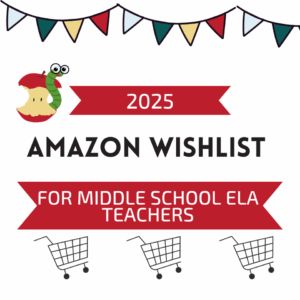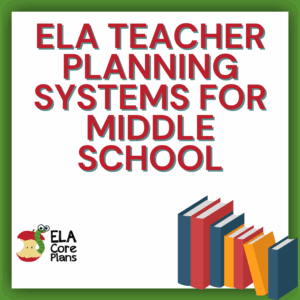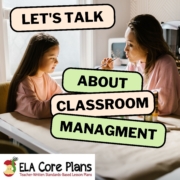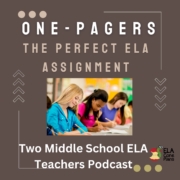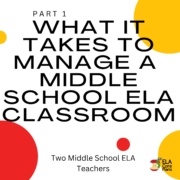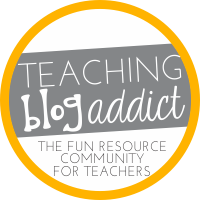Over the years, I’ve witnessed significant changes in what it takes to manage a middle school ELA classroom. It seems that each year, there’s always new technology and social media, which we all know brings drama to the hallways of any middle school. There is also evolving social dynamics, and we won’t even mention the shortened attention spans of our students. The truth is our classrooms are continually changing and challenging.
And I see new teachers in my building and all over social media who look and sound defeated and who want to quit because they just can’t figure out what it takes to manage a middle school ELA classroom. So, if you’re someone who feels that way, I’d like to say first of all, that I get it. I’ve been there. But, I’d also like to say to just hold strong… Just hold on and give it a little time. I was told when I first started teaching to give it three years, and I still think that is solid advice. The days of a one-size-fits-all approach are long gone. But in three years, your classroom management will get better and better, and it will get easier, and then as you continue teaching, you will continue to improve your classroom management, until it is successful.
Now, I want to state right now that I don’t have all of the answers when it comes to what it takes to manage a middle school ELA classroom. What I do have is years of experience and wisdom that I have gained by trying and failing and trying again. I bring with me 24 years of experience, exclusively in middle school classrooms. I’ve taught 6th grade, 7th grade and 8th grade ELA in a school with classrooms that have often presented challenges when it comes to behavior.
First, I would like to take you back to my first years of teaching. My very fist year, I was 22, fresh out of college and super excited about my first classroom and my first students. However, if you asked me then what it takes to manage a middle school ELA classroom, I would have told you that I was struggling to know. I won’t even go into the fact that the Internet wasn’t even around yet, so there was no way for me to find blogs like this to help. Anyway, I did have some of the ingredients that I needed in those years to be a good teacher, but looking back, it’s easy to see a lot of what I was lacking.
I specifically remember one class I had in those early years and a student who everybody called Day Day. There were only about ten students total in Day Day’s class, but I couldn’t do one thing with them. In fact, Day Day ran my classroom, not me. And I loved her. I LOVED her, but if I’m being honest, I guess I was also slightly scared of her. If Day Day didn’t want to sit down, she didn’t. If she didn’t want to do the work we were doing, she didn’t. I vividly remember one day during class, I was reading something to my students, and Day Day was braiding my hair! True story. Now, this is a little embarrassing to admit, and remember now, there was no teachers pay teachers or blogs or well really anything to help me out. All I had was what I learned in college, and when it came to the Day Day’s, that just wasn’t cutting it.
The one thing I did have then was the passion I needed to be a good teacher. I also had the skills to develop good relationships with my students. Just as much as I loved Day Day, she loved me back… I would argue that they all loved me. But there were days after school when I would sit at my desk and cry. I knew that even though I had good relationships and great lessons, my kids weren’t learning every day. I lacked classroom management.
So the first, and yes, I would argue, the most important ingredient you and I need to successfully manage a middle school ELA classroom is the ability to develop relationships with students. But, that alone will not cut it. However, I truly believe that relationships is the foundation. You must have positive relationships before anything else, so let’s start here.
How can you build those relationships? How can you get to know your students? With ELA, it can be really hard because we have so much to cover and so much to do. There isn’t a lot of time for chit chat. What our subject does lend us to, however, is the chance for storytelling.
What it Takes to Manage a Middle School ELA Classroom ~ A Little Story Sharing
In ELA class, we’re always reading and writing, right? When you’re reading a story or having students write something, take the opportunity to share with them stories from your own life. Most ELA teachers are pretty good storytellers. Don’t hold back in sharing some of the crazy things that have happened to you over the years as the opportunity arises. I have always done this and I truly believe it has helped my classroom climate.
One time I was on an airplane and this man sat beside me. Five minutes into the flight, he started screaming that the plane was going to go down. I was terrified. I have a seriously suspenseful and funny way of telling that story. I go into details about what I was thinking, how I wanted to kill my husband who was sitting in front of me and didn’t jump up to help. My students hang on every word…and that storytelling.. that letting them get a glimpse of Mrs. Temple outside in the real world, helps them to warm up to me, to like me, to see me as a regular human and not just a teacher. And you know how it is, when you share a story, their hands go up, and they want to share their own. My advice is to allow this from time to time. I know we’re busy. I know we have standards, and I know that kids want to get us off topic to waste time, but if you will allow this every once in a while, your classroom climate will become more positive and your room will become more of a fun place to be. And those times when you don’t have time to listen to story after story, have them turn to a partner and share and then tell them to come up with only two sentences that sum up the story and let them share that way. Their stories will help you learn about them as well.
Here are some other more intentional ways that you can build relationships with your students.
What it Takes to Manage a Middle School ELA Classroom ~ A Little Letter Writing
At the beginning of the year, have your students address an envelope to themselves, or a postcard if you want to get fancy. Then, spend some time within the first months of school writing a letter to each kid. This takes time, but it is such a personal gesture that will go a long way in building relationships. Brag on things that you’ve noticed about them, even those kids who may seem to be giving problems. A kid who stirs trouble for example could be told, “I have seen how you are such a leader and how others listen to you. I am excited to see how you can use those leadership skills in a future career, and I’m so glad I get to be your teacher and part of your story to help you get to that future that is so bright for you.”
What it Takes to Manage a Middle School ELA Classroom ~ A Little Praise
Some students never receive praise from adults so this can really make a difference, and speaking of praise, this is the next way to build relationships. Praise them! Praise them individually and as a class. You will see a huge difference. Say things like “I am so lucky that I get to teach you guys.” or “My job is the best because I get to hang out with all of you!” Praise them in the hallway, in the lunchroom, and in your classroom. Praising your students is a way to build relationships with them. Do it for the whole class and take the time to give individual students praise too, even the most challenging students.
What it Takes to Manage a Middle School ELA Classroom ~ A Little Time to Ask Questions
Another way that you can build relationships is to ask your students a question as they enter your classroom. We all know that we should greet them at the door. Why not greet them with a question that will help you get to know them? One fun thing you can try, even if it’s just once a week is a “would you rather question”. Ask each kid the question as they come in and get their response. Then, when you start class, you can repeat the question, tell them your answer and have them stand up to show who answered what. This would only take seconds, and if you want to only do it once a week, you could call it “Would You Rather Wednesdays”. If you don’t want to use would you rather questions, you could just ask regular “get to know you questions” like Do you have siblings? Dogs or cats? What’s your favorite candy?
In conclusion, developing strong relationships with your students is the key to successfully managing a middle school ELA classroom. By sharing personal stories, taking the time to write individual letters to students, and offering genuine praise, you can establish a positive and supportive classroom environment. Additionally, incorporating fun icebreaker questions like “Would You Rather” can help you get to know your students better and create a sense of community.
While building relationships is crucial, it’s important to note that it is just the foundation for effective classroom management. In the next blog post and podcast, I will delve into specific techniques and strategies that can be employed to manage a middle school ELA classroom successfully. These techniques will address the challenges posed by changing classroom environments, evolving social dynamics, and shortened attention spans of students. Stay tuned for valuable insights and practical tips on managing your ELA classroom with confidence and success.
Download this episode.

